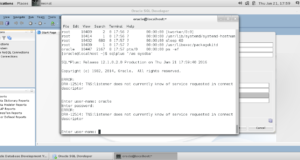REQUEST COMPLIMENTARY SQLS*PLUS LICENCE
Oracle TRIM method

In Oracle PL/SQL TRIM method removes all items from any collection type. This operation immediately frees up the memory allocated to the items to be removed.
Syntax of TRIM collection method in Oracle PL/SQL
collect_name_id.TRIM;
collect_name_id.TRIM (n);
Parameters or arguments
- collect_name_id – is the name of the collection.
- TRIM – removes one element from the end of the collection if the collection has at least one element.
- TRIM (n) – removes n items from the end of the collection if the collection has at least n items at the end.
If there are no items in the collection, the predefined exception SUBSCRIPT_BEYOND_COUNT is called.
TRIM works with the internal size of the collection. That is, if DELETE deletes an item but saves its filler, TRIM considers that this item exists. Therefore TRIM can remove the removed item.
PL/SQL does not hold a filler for the clipped items. Therefore, the cropped items are not part of the internal size of the collection, and you cannot recover the cropped item by assigning it a valid value.
TRIM works with the internal size of the collection. That is, if DELETE deletes an item but saves its filler, TRIM assumes that the item exists. So TRIM can remove the removed item.
PL/SQL does not hold a filler for the trimmed items. Therefore, the cropped items are not part of the internal size of the collection, and you cannot recover the cropped item by assigning it a valid value.
Do not rely on interactions between TRIM and DELETE. Process Nested Tables as varray arrays (and use only DELETE) or stacks (and use only TRIM and EXTEND).
Consider an example to understand how to use the TRIM collection method in Oracle PL/SQL.
Example of TRIM with Nested Tables
Let’s consider an example where we declare the Nested Tables variable:
|
The print_nt_id procedure prints the nested table variable after initialization and after TRIM and DELETE operations.
CREATE OR REPLACE TYPE nt_type_id IS TABLE OF NUMBER;
CREATE OR REPLACE PROCEDURE print_nt_id (nt nt_type_id) IS
i NUMBER;
BEGIN
i := nt.FIRST;
IF i IS NULL THEN
DBMS_OUTPUT.PUT_LINE('nt is empty');
ELSE .
WHILE i IS NOT NULL LOOP
DBMS_OUTPUT.PUT('nt.(' || i || ') = '); print(nt(i));
i := nt.NEXT(i);
END LOOP;
END IF;
DBMS_OUTPUT.PUT_LINE('---');
END print_nt_id;
DECLARE
nt nt_type_id := nt_type_id(11, 22, 33, 44, 55, 66);
BEGIN
print_nt_id(nt);
nt.TRIM; -- Cuts off the last element
print_nt_id(nt);
nt.DELETE(4); -- Delete the fourth element
print_nt_id(nt);
nt.TRIM(2); -- Cuts off the last two elements
print_nt_id(nt);
END;
Result:
nt_id.(1) = 11
nt_id.(2) = 22
nt_id.(3) = 33
nt_id.(4) = 44
nt_id.(5) = 55
nt_id.(6) = 66
---
nt_id.(1) = 11
nt_id.(2) = 22
nt_id.(3) = 33
nt_id.(4) = 44
nt_id.(5) = 55
---
nt_id.(1) = 11
nt_id.(2) = 22
nt_id.(3) = 33
nt_id.(5) = 55
---
nt_id.(1) = 11
nt_id.(2) = 22
nt_id.(3) = 33
—
PL/SQL Collection Method TRIM in Oracle Database
MORE NEWS
PreambleNoSql is not a replacement for SQL databases but is a valid alternative for many situations where standard SQL is not the best approach for...
PreambleMongoDB Conditional operators specify a condition to which the value of the document field shall correspond.Comparison Query Operators $eq...
5 Database management trends impacting database administrationIn the realm of database management systems, moreover half (52%) of your competitors feel...
The data type is defined as the type of data that any column or variable can store in MS SQL Server. What is the data type? When you create any table or...
PreambleMS SQL Server is a client-server architecture. MS SQL Server process starts with the client application sending a query.SQL Server accepts,...
First the basics: what is the master/slave?One database server (“master”) responds and can do anything. A lot of other database servers store copies of all...
PreambleAtom Hopper (based on Apache Abdera) for those who may not know is an open-source project sponsored by Rackspace. Today we will figure out how to...
PreambleMongoDB recently introduced its new aggregation structure. This structure provides a simpler solution for calculating aggregated values rather...
FlexibilityOne of the most advertised features of MongoDB is its flexibility. Flexibility, however, is a double-edged sword. More flexibility means more...
PreambleSQLShell is a cross-platform command-line tool for SQL, similar to psql for PostgreSQL or MySQL command-line tool for MySQL.Why use it?If you...
PreambleWriting an application on top of the framework on top of the driver on top of the database is a bit like a game on the phone: you say “insert...
PreambleOracle Coherence is a distributed cache that is functionally comparable with Memcached. In addition to the basic function of the API cache, it...
PreambleIBM pureXML, a proprietary XML database built on a relational mechanism (designed for puns) that offers both relational ( SQL / XML ) and...
What is PostgreSQL array? In PostgreSQL we can define a column as an array of valid data types. The data type can be built-in, custom or enumerated....
PreambleIf you are a Linux sysadmin or developer, there comes a time when you need to manage an Oracle database that can work in your environment.In this...
PreambleStarting with Microsoft SQL Server 2008, by default, the group of local administrators is no longer added to SQL Server administrators during the...















